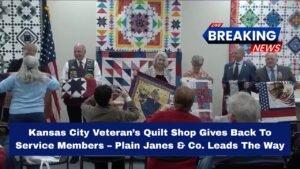For residents in rural Kansas, especially those in Miami County, affordable public transportation is not just a convenience—it’s a lifeline.
But now, the future of the General Public Transportation ride service is uncertain as funding becomes more difficult to secure and partner organizations struggle to sustain operations.
At the Louisburg Senior Center, where community members recently gathered for a birthday lunch, conversations turned serious as many rely on the center’s transportation program to get to doctor appointments, grocery stores, and social outings.
“They pick me up every morning and take me home,” said 95-year-old Bertie Dinkle, one of 24,000 county residents who depend on the service each year.
Federal and State Support Not Enough
The service is primarily funded by the Federal Transit Administration’s 5311 Grant, distributed through the Kansas Department of Transportation (KDOT). The grant supports:
- Vehicle purchases
- ADA-accessible transit equipment
- Driver wages and insurance
- Maintenance and outreach
But local leaders like Misty Norton, director of Mobility Management for East Central Kansas Coordinated Transit Council #5, say those resources no longer meet the growing demand.
“For some people, this is their livelihood,” Norton said. “They don’t have a vehicle. It’s not just about medical needs—it’s about being part of the community.”
Programs Already Facing Cutbacks
In May 2025, the Miami County Republic reported looming service reductions. The Paola Senior Center has already confirmed it will cease its General Public Transportation service by summer 2026, citing budget shortfalls and rising operational costs.
“They’re operating at a deficit,” Norton said. “Donations have become their primary source of financial support.”
Calls for Collaboration and Centralized Oversight
One proposed solution is the creation of a centralized dispatch system and the merging of senior center budgets into a single operating entity. This could improve financial management and accountability across services currently spread between Paola, Osawatomie, and Louisburg.
Norton also supports the idea of forming a non-profit organization to take over the transportation system, allowing for streamlined fundraising and oversight.
“We can’t expand our reach if we’re stuck managing inefficiencies,” she said.
Mixed Progress and Missed Opportunities
Despite urgent needs, coordination remains a challenge. Norton and Carol Rhea, Director of the Osawatomie Senior Center and Chair of the Miami County Council on Aging, agree that leadership among involved groups lacks consensus on a clear direction.
Meanwhile, the Miami County Commission is finalizing its 2026 budget, but officials say the transportation study group has not submitted requests or recommendations for additional funds. As a result, no increases are anticipated in next year’s budget for general transportation.
“Unfortunately, I think we missed it this time,” Norton admitted. “But hopefully next year, we’ll be ready. Sadly, some people may be left without a ride.”
Local Efforts Step In
Community organizations are stepping up where they can. Gordon Schrader, President of the Community Senior Center Board, confirmed they’ve purchased a vehicle for medical transport to help fill gaps.
“We don’t have the capacity to take on Paola’s 8,000 annual rides, but we’re doing what we can,” Schrader said. “We’ll continue seeking local donations and additional grants.”
Mounting Costs Add Pressure
Louisburg Senior Center Director Rhonda Kerr noted that monthly operational costs—including fuel, maintenance, and driver wages—are rising quickly.
“Sometimes the senior center has to cover the shortfall,” Kerr said. “Any funding we receive—state, federal, or private—goes directly to keeping this service running.”
The General Public Transportation program in Miami County, Kansas, is facing a crossroads. As funding dwindles and transportation demands increase, community leaders and organizations are pushing for more collaborative strategies to keep this essential service afloat.
Without immediate solutions and unified planning, many rural residents could lose their only means of safe, reliable transportation—putting their health, independence, and community connection at risk.




